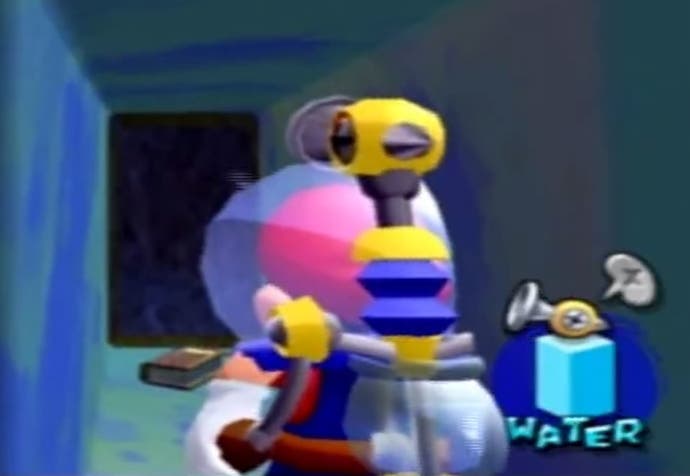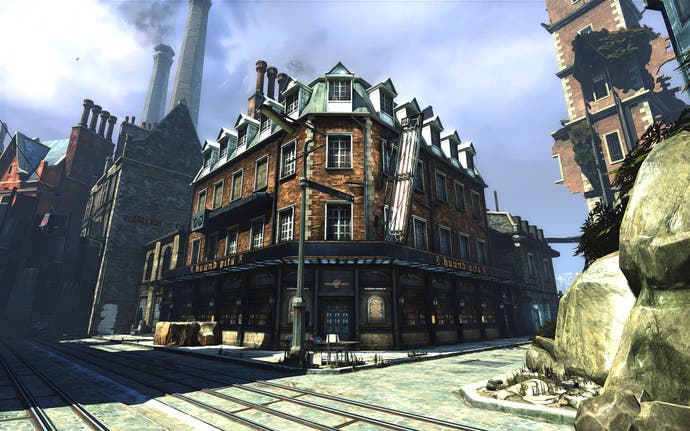Chris Donlan on: Closed doors
What do Bloodborne, Mario and Dishonored have in common?
There is a book at the bottom of the ocean. A book that Mario will never get to read. He can stare at the book through the cracks in a door, but he will forever be unable to reach it. He can do so much, Super Mario, but access to this particular book is beyond him.
It's maddening! It's also thrilling. And it's also Noki Bay's red coin hunt in Super Mario Sunshine. This is a game that is better than most people recall, I suspect - although the real problem is that most people don't recall it very often in the first place. Whenever I think of Mario Sunshine, I don't think of FLUDD, or even the fact, once pointed out in an Edge Time Extend, that Mario genuinely does a spot of plumbing on this outing. I think of the book, resting behind a closed door at the bottom of a deep ocean that is itself stuck inside a bottle. Twice trapped, never to be freed. Quite a fate.
Games need more closed doors. Or rather, they need more doors that look like you should be able to open them. I am speaking of something fairly specific here - not the doors-as-set-dressing that politely line the corridors in so many first-person shooters. Those are doors you would never think to open. With Noki Bay's door, however, once you find it, you can't think of anything else. It's so tantalising! And not just because you can swing the camera around and get a glimpse of the room that lies beyond it, the room where an old book lies waiting on the sand. It's tantalising because this is what Nintendo does. Ever since the very first Zelda, the trick has been to tease you with something you can see but can't get to, and then challenge you with getting to it anyway.

Hunting around the internet, it seems that maybe Japanese players could reach the book. The door was apparently a clumsy addition for the Western release when the plans had changed and the fun had moved elsewhere. (The book, rather worryingly, was titled, 'You have no Life.') This is what I love about games, particularly the polished ones: I love the moment where the fiction breaks down slightly, and you see the hand of the designer - even a rushed designer who's merely applying digital Polyfilla. It suggests a true mystery that lies beyond any fabricated mystery that the game itself has created for you on purpose. It suggests a mystery that will not depart even when it has been solved. It's just a bug, it's just something included for a different market. That doesn't matter: because you know, now, you know. You are reminded in a strangely intimate way that all of this has been made, and you are free to wonder afresh about the people who made it.
This week brought a brilliant example of this. Another door, this one in Bloodborne, sealed tight and bearing the single word: 'Closed'. This mystery has a rather literary feel to it too, and not just because of that John Updike quote about a short story being a room on whose walls many false doors have been painted. Words count in Bloodborne, and 'Closed' seems to have been employed to give very little away. Not locked. Not opening from the other side. Just closed.
Everyone will have their own favourite examples of this sort of thing. My own is probably Dishonored, a game that I enjoyed more for its hub than for most of its campaign. (It is by no means alone here: hubs are brilliant, but that's a discussion for another day.) Dishonored's campaign was a parade of rooftops and open windows and large men waiting to be shivved. Its hub, though? Its hub was a salty old boozer, sticky-carpeted and flock-wallpapered. You could wander around to your heart's content, or so you thought, because when you did wander, you discovered that one floor was completely out of bounds: bricked-up doorways interspersed with windows you couldn't access.
Again, this was a game that was all about getting places you weren't meant to be, so this mocking chunk of inaccessibility, right in the center of your own turf, was pretty much a call to arms. A challenge! (Tom Bramwell eventually solved this mystery, incidentally; it was a volumes thing. The pub looked too squat without an extra floor when viewed from the outside. On the inside, though, there was nothing worthwhile to put there, so the whole thing was bricked up to avoid confusing players. Developers are increasingly jobbing builders, it seems; the truth, once again, didn't really matter.)
Part of the reason this stuff counts, I think, is that when games are so finely detailed, so carefully constructed, and so unwilling to leave anything to chance, you treasure the moments where that all falls down even more than normal. Big budget games are increasingly good at everything except creating an air of genuine mystery, because you cannot plan for mystery and you cannot account for it in a spreadsheet - and you cannot spend a big budget without planning and accountancy and spreadsheets. Look back to the Commodore 64 era and mystery seemed to be everywhere, because games were problematic artifacts made by potentially problematic individuals. You got a sense of their peculiar views of the world along with the things they built, and there was no chance of separating the elements. You couldn't help but learn a bit about Matthew Smith by playing Jet Set Willy, for example. Now there's a guy who would appreciate a closed door.

There's also something a bit more mystical to it, perhaps. Fudges and botches and things that simply should work, but don't, offer an unusually vivid insight into the creator. Take the glimpse of Miyazaki you get through the keyhole of the door that will not open. You sense this is not a mistake or a plan that has changed for tedious reasons so much as it is a practical joke at your expense, coming from a man who is not averse to joking with his players. Take the missing floor in Dishonored: a necessary casualty for a team that seems inspired, above all else, by how the world they are creating should look. Take the book at the bottom of Noki Bay... Actually, I can't really solve that one. Which is probably why it's the best one.
From here, I could easily segue to Bulkington, a character in Moby-Dick who is introduced with great fanfare and then all but disappears - a textual closed door, of sorts, in the form of a ghost from an earlier draft. We need more ghosts in games, surely? More intrusions from early drafts? I feel I've done Bulkington to death, though, just as I should probably retire that Updike quote. Instead, let's go topical on the theme of botches, glitches, and glimpses of the unknown. Let's turn our gaze to the stars - and then back down to earth.
Have you heard of perytons? They're radio signals: intriguing emissions, possibly from deep space, that appear to have intelligence lurking undeniably inside their compacted patterns. Dan Pearson of our sister site GamesIndustry and I have spent quite a bit of time in the office discussing these things over the last few months - and discussing what we'll do when the spaceships start to land. That's all done with now, though, because one of the big sources of perytons has been found, and unfortunately it's not a genius ET hailing us from a distant galaxy. Instead, it's a microwave oven in the canteen of a radio telescope, sending out a mindless chunk of noise that gets mistaken for an intelligent signal.
Glitches and closed doors and dead ends; unreadable books and errant microwaves. These things belong together. We need them, if only to drive us to distraction when nothing else can.


